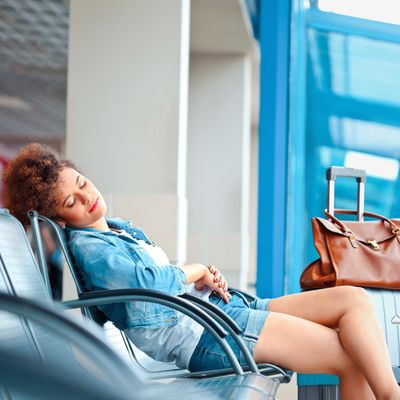
My approach to jet lag has never been terribly scientific. For umpteen years of fashion shows in Europe, my plan was simple: Pop half an Ambien on the plane after takeoff, sleep a few hours, shower quickly at the hotel, and teeter from back-to-back shows straight through dinner. If I was lucky, I’d be in bed by midnight. And it worked — until the afternoon of day two, when I’d settle into Fashion Week’s comfiest chair at the Armani theater. The lights would go down, and so would I. Instead of admitting I was jet-lagged, I just self-medicated with espresso and concealer.
On a trip to Japan last week, I was worried about what jet lag could do to me. I’ll spare you the Lost in Translation cliché. The purpose of my trip was to make a speech for Shiseido about changing attitudes toward beauty. I needed to be sharp, witty, or, at the very least, coherent. I couldn’t risk being a zombie.
My one real previous effort at a jet-lag treatment was a flop. Long ago, I consulted a book called Overcoming Jet Lag and its complicated program involving feasting and fasting on alternate days, with bizarrely timed rations of coffee. At the airport in New York on my way to London in the mid-’80s, I lined up seven — yes, seven — cups of black coffee on the cafeteria tray, alarming the cashier and a couple from Germany. Don’t worry, I said, this is a new jet-lag cure. I drained all seven cups and proceeded to spend the entire flight shaking and bug-eyed. When I got to London, I went straight to bed and missed the tour of the V & A. Fail.
I don’t believe in those homeopathic No-Jet-Lag tablets in health-food stores, maybe because they’re sold next to the Drink Ease hangover remedies. Besides, on the No-Jet-Lag website, the first instruction is, “Before departing, make sure you have all your affairs, business and personal, in order,” which sounds both ominous and impossibly ambitious. Another eerie concept is the Human Charger from Finland, earbuds that beam light rather than sound, allegedly to manipulate the body clock. The only problem is, in humans, light can only affect the brain by coming through the eyes, not the ears, nostrils, or any other orifice.
When I consulted a legitimate doctor, Noel Taylor, about legitimate Ambien, she told me she used stopjetlag.com for a trip to the Maldives and sailed through the vacation without a hiccup. No Ambien needed.
For $40, the Stop Jet Lag site or app calculates a schedule of meals, caffeine, light exposure, sleep, and melatonin supplements based on your flight time and destination. For me, that meant a high-protein breakfast and lunch the day before my departure, and then, cruelly, no caffeine and light meals on the morning of my flight. I nodded off in the airport lounge and fell asleep immediately after takeoff. I dozed a good eight hours, switched my watch 13 hours ahead to Japan time, and ate nothing on the plane until hour ten. When I arrived at my hotel around 5 p.m., I took a shower and made a reservation at a sushi bar for 8:30 p.m. Back at the hotel at 11, I popped a melatonin pill and slept until 6:30 a.m., which is more sleep than I get at home. My schedule was pretty much nonstop from then on, and I didn’t drool or pass out once. In fact, I felt almost obnoxiously perky every day until bedtime.
On the return trip I was able to sleep eight hours on the plane, following my Stop Jet Lag plan, and had no food until breakfast on New York time. I resisted the urge for a welcome-home soy latte — the first day back is a no-caffeine day — and a long afternoon nap. And even though I was groggy and a little stupid for a few days, I managed to stay awake until 11 every night. It was practically a miracle.
It turns out the doctor who wrote the first jet-lag program I tried (and failed) was also behind Stop Jet Lag. Charles F. Ehret, a pioneer in chronobiology at the Argonne National Laboratory, worked with Bill Ashton, a computer scientist, to refine his original program, making it less wacky and more effective. (Dr. Ehret died in 2007.) “We gear everything — sleep, meals, caffeine, light exposure — around your travel times and where you’re going,” said Ashton. “Generally, early birds have an easier time going east and night owls feel better going west. But the rules of thumb can throw you off if you follow them at the wrong time.”
Of all the variables that influence the body clock, light exposure seems to be the most powerful. A recent study published in the Journal of Clinical Investigation concluded that brief flashes of bright light delivered at specific intervals before and during travel can practically eliminate jet lag. “We did the study in a laboratory, and it’s impractical and extremely annoying,” said the study’s lead author, Jamie Marc Zeitzer, an assistant professor of psychiatry and behavioral sciences at Stanford University School of Medicine’s sleep center. Zeitzer is working with a company to produce a sleep mask that’s neither impractical nor annoying (he said he has no financial interest in the company). The mask is embedded with a thin LED panel that’s programmed by a smartphone app. The light in the mask tinkers with the user’s circadian rhythms by flashing at the beginning of the night if you’re traveling west, and at the end of the night if you’re going east. “The light doesn’t seem to wake up most people,” he said. “We’re studying how long, how short, and how bright the light should be.” The mask, from LemosTech, may be available as soon as this summer, just in time for that trip to Ibiza. Or Finland.




